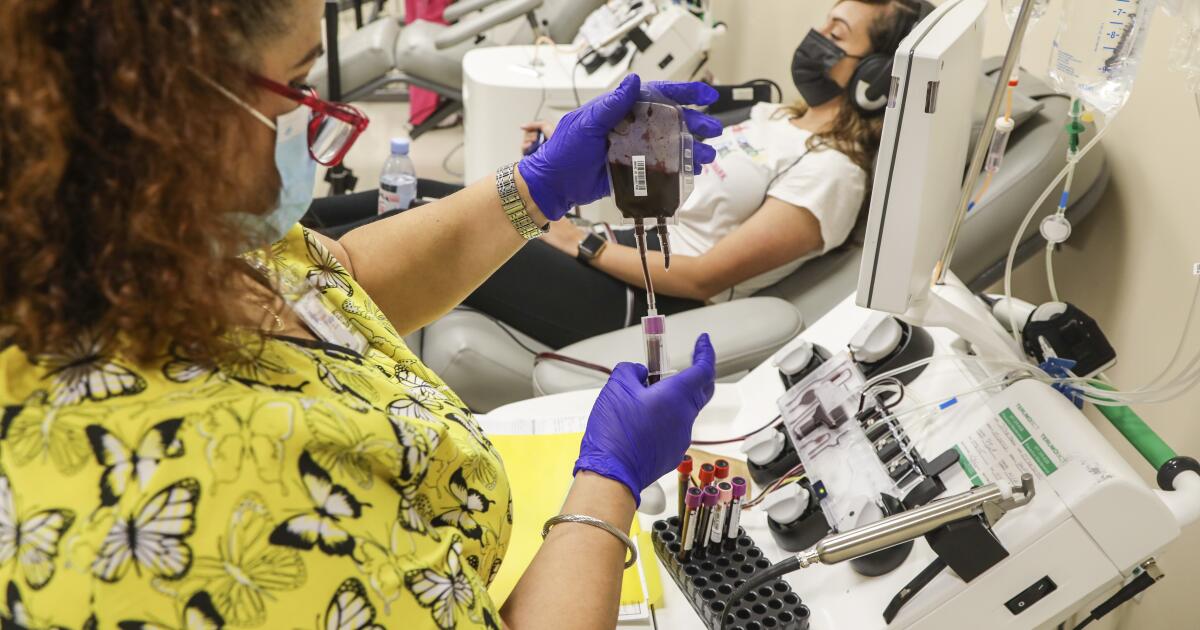Blood
Opinion: Only a fraction of local blood donors are people of color. Here’s why that’s a problem.
Nayak is the chief business officer of San Diego Blood Bank. He lives in Scripps Ranch.
When most people think about blood transfusion patients, their mind automatically goes to someone who has just been injured or needs life-saving emergency surgery. This is part of the reason why blood donations spike after earth-shattering events or natural disasters.
But of the 18 million blood transfusions that happen each year in our country, most of those are patients who have a need to be chronically transfused, mostly due to genetic blood diseases or cancer treatment. It’s critical for blood transfusion patients to receive a close match to their own, and research has shown that race and ethnicity, in addition to blood type, play a role in this. However, for many chronically transfused patients, especially those of Black, Hispanic/Latino or South Asian descent living with life-altering conditions like sickle-cell disease or thalassemia, it can be hard to find blood matches that allow them to thrive and respond positively to treatment.
San Diego Blood Bank is trailblazing the medical field on these patients’ behalf, through our Precision Blood initiative, which aims to match donor blood even more specifically to patients who need it. Through generous donations from the Cushman Foundation and the David C. Copley Foundation, we’re advancing a clinical trial of the Precision Blood program for patients at Rady Children’s Hospital. If successful, this study will lead to breakthroughs that transform the standard of care for blood transfusion patients.
We are fortunate to be part of a culturally diverse region, with a wide range of potential donors from various ethnic backgrounds — potentially leading to more chronically transfused patients receiving a better blood match and living longer, healthier lives. But in order for this clinical trial to be as successful as it could be, we need more people in our community, particularly those of Black, Hispanic/Latino and Asian/Pacific Islander descent, to step up and help their communities by donating blood.
Firstly, there are far more than just the eight standard ABO blood types (A positive, A negative, B positive, B negative, O positive, O negative, AB positive, AB negative) to consider when it comes to matching donor blood with a recipient. Research has shown that there are actually more than 30 different blood groups and hundreds of different antigen markers that can determine how well a donor and recipient’s blood match. And while every person is unique, people of similar racial or ethnic backgrounds often have more similar blood types and antigen markers.
Scientists have found that a basic blood match versus a precise blood match could make the difference in a patient’s disease progression — and even be the difference between life and death. The less accurately blood is matched, the more likely patients’ bodies are to develop a resistance to donor blood, which weakens their ability to heal and respond to treatment.
Now, the facts about blood donation. Less than 3 percent of eligible people donate blood, and the vast majority of regular blood donors are white. While San Diego Blood Bank outperforms many other blood banks nationwide in efforts to recruit donors that reflect the diversity of its regional community, there is still work to do. Approximately 63 percent of our blood donors are Caucasian, while only 11.6 percent are Hispanic/Latino, 7.9 percent are Asian/Pacific Islander and 1.5 percent are Black.
San Diego Blood Bank acknowledges there may be cultural barriers and beliefs that have kept more people of color from donating blood. Mistrust in the medical establishment rooted in generations of experience with structural racism, misconceptions about the blood donation process, lack of awareness due to language barriers and other factors all contribute to a lack of diversity in our regular blood donor pool. But by creating a wider and more diverse blood pool that offers better-tailored donor blood to the diverse populations of our community, we can create better medical outcomes for people of all backgrounds and undo some of the harmful consequences of health inequity in the past.
So if you’re eligible to donate blood, please donate. Encourage your friends and family to donate. Organize a blood drive in your neighborhood. If you’re curious, come to our headquarters and see what we’re doing. We’re happy to show you the positive difference your blood donations make, and talk to you about the patients who benefit. Not all superheroes wear capes — become one and save lives by donating blood and encouraging your family, friends and community to do so.

